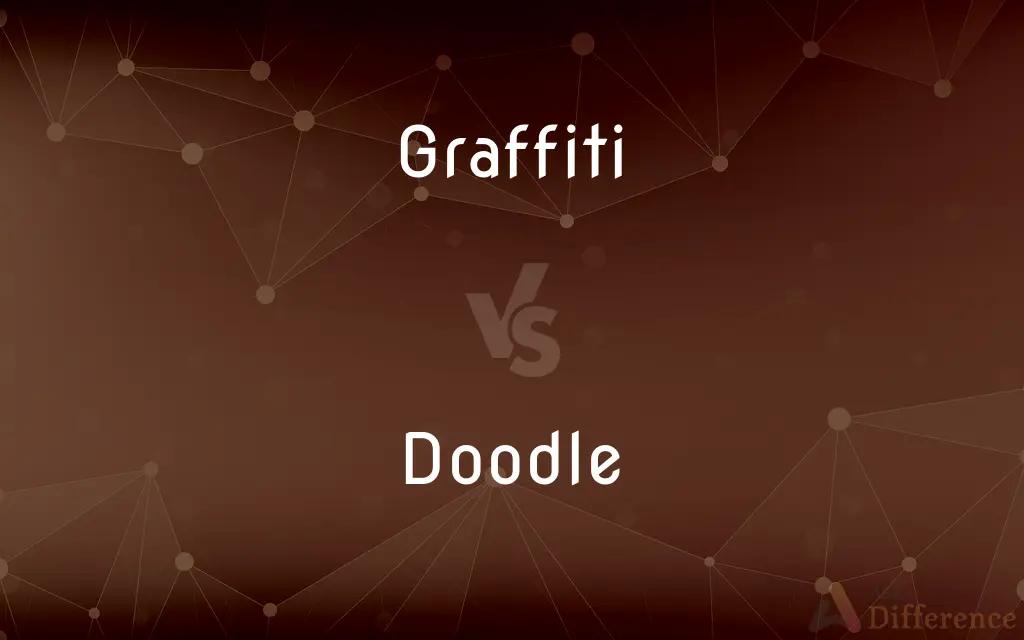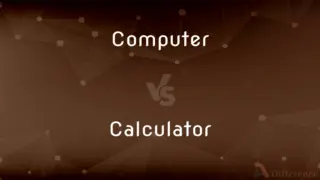Graffiti vs. Doodle — What's the Difference?
Edited by Tayyaba Rehman — By Maham Liaqat — Updated on April 1, 2024
Graffiti is a form of public art, often illegal, using walls or surfaces as a canvas, whereas doodles are simple drawings made absentmindedly.

Difference Between Graffiti and Doodle
Table of Contents
ADVERTISEMENT
Key Differences
Graffiti is a type of expressive artwork created on public or private surfaces, typically walls, and often without permission, making it illegal in many contexts. It ranges from simple written words to elaborate wall paintings. On the other hand, doodles are informal drawings or scribbles, usually made without full attention, often while doing another activity like talking on the phone or attending a meeting. They are generally private, found in notebooks or margins of documents.
While graffiti artists may use a variety of tools including spray paint, markers, and stencils to create detailed and complex pieces, doodlers often use whatever is at hand, such as a pen, pencil, or marker, focusing on simplicity and spontaneity. Graffiti often carries a message or expresses the artist's thoughts on societal issues, whereas doodles are personal, reflecting the doodler's current mood or state of mind without intending to convey a public message.
The creation of graffiti is usually planned and executed with specific goals or messages in mind and can be considered a form of public art or vandalism, depending on one's perspective. Doodles, however, are spontaneous and unplanned, often created subconsciously while the individual's focus is elsewhere. They are rarely intended for public display.
Legal distinctions mark another significant difference: graffiti, especially when unauthorized, can lead to legal penalties, highlighting its contentious nature within public spaces. Doodles, being private and non-invasive, do not involve legal concerns, emphasizing their harmlessness and personal context.
In cultural perception, graffiti is often associated with urban environments and can be seen as an act of rebellion or social commentary, while doodles are universally recognized as a common, casual activity with no cultural or societal implications. The intention behind graffiti is to make a visual statement in a public space, while doodling is a personal act of distraction, relaxation, or subconscious expression.
ADVERTISEMENT
Comparison Chart
Definition
Public art or vandalism using surfaces as canvas.
Simple, informal drawings made absentmindedly.
Tools Used
Spray paint, markers, stencils.
Pen, pencil, or any writing instrument at hand.
Message
Often carries a social or personal message.
Rarely intended to convey a message.
Execution
Planned and deliberate.
Spontaneous and unplanned.
Legal Implications
Can be illegal and lead to penalties.
Private and non-invasive, without legal issues.
Cultural Context
Associated with urban environments, rebellion.
Seen as a casual, universal activity.
Compare with Definitions
Graffiti
Can lead to legal action if done without permission.
The graffiti artist faced fines for using the building's wall as a canvas without consent.
Doodle
Spontaneous, often occurring subconsciously.
Without realizing it, she doodled stars and circles throughout her lecture notes.
Graffiti
Artistic expressions created on public or private surfaces.
The alley was covered in graffiti, turning a bland wall into a vibrant mural.
Doodle
Simple drawings made while the mind is otherwise occupied.
Her notebook was filled with doodles from countless meetings.
Graffiti
Utilizes spray paints, markers, and stencils for complex pieces.
The artist used spray paint to craft the graffiti, filling the cityscape with color.
Doodle
Created with whatever writing instrument is available.
I doodled on the corner of my page with a ballpoint pen during the call.
Graffiti
Involves planning and deliberate execution.
Planning the graffiti took weeks, ensuring each element contributed to the overall message.
Doodle
Lacks a deliberate message, reflecting spontaneous thought.
The doodles were abstract, reflecting his absentminded creativity.
Graffiti
Often reflects social commentary or personal expression.
The graffiti on the bridge served as a poignant commentary on social inequality.
Doodle
No legal concerns, as doodles are private and harmless.
Doodling during class was a harmless way to pass time, involving no risk.
Graffiti
Graffiti (both singular and plural; the singular graffito is rarely used except in archeology) is writing or drawings made on a wall or other surface, usually without permission and within public view. Graffiti ranges from simple written words to elaborate wall paintings, and has existed since ancient times, with examples dating back to ancient Egypt, ancient Greece, and the Roman Empire.Graffiti is a controversial subject.
Doodle
A doodle is a drawing made while a person's attention is otherwise occupied. Doodles are simple drawings that can have concrete representational meaning or may just be composed of random and abstract lines, generally without ever lifting the drawing device from the paper, in which case it is usually called a "scribble".
Graffiti
Writing or drawings scribbled, scratched, or sprayed illicitly on a wall or other surface in a public place
The station was covered in graffiti
Doodle
Scribble absent-mindedly
He was only doodling in the margin
Graffiti
Write or draw graffiti on (something)
The graffitied walls
Doodle
A rough drawing made absent-mindedly
The text was interspersed with doodles
Graffiti
Drawings or inscriptions made on a wall or other surface, usually without permission and so as to be seen by the public.
Doodle
To draw or sketch aimlessly, especially when preoccupied.
Graffiti
Drawings or words drawn on a surface in a public place, usually made without authorization.
The underpass is a popular place for graffiti artists.
The city council spends thousands of pounds removing graffiti from public buildings.
Doodle
To kill time; dawdle.
Graffiti
Informal inscriptions, figure drawings, etc., as opposed to official inscriptions.
Doodle
To draw (figures) while preoccupied.
Graffiti
(transitive) To mark a surface with such images.
Doodle
A figure or design drawn or written absent-mindedly.
Graffiti
Inscriptions, figure drawings, etc., found on the walls of ancient sepulchers or ruins, as in the Catacombs, or at Pompeii.
Doodle
(obsolete) A fool, a simpleton, a mindless person.
Graffiti
Any writings or drawings on a surface in a public place, placed there without authorization of the owner of the object on which it is written. Such graffiti are usually unwelcome, and are considered as form of vandalism.
Doodle
A small mindless sketch, etc.
Graffiti
A rude decoration inscribed on rocks or walls
Doodle
Any crossbreed of a poodle with a different breed of dog.
Doodle
(ambitransitive) To draw or scribble aimlessly.
The bored student doodled a submarine in his notebook.
Doodle
(Scotland) To drone like a bagpipe.
Doodle
A trifler; a simple fellow.
Doodle
An aimless drawing
Doodle
Make a doodle; draw aimlessly
Common Curiosities
What is graffiti?
Graffiti is artwork or writing painted, sprayed, or scribbled on public or private surfaces, often without permission.
Why do people doodle?
People doodle for various reasons, including boredom, distraction, relaxation, or subconscious expression.
Can graffiti be legal?
Yes, graffiti can be legal if done with permission on designated surfaces or for commissioned projects.
How do graffiti and doodles differ in purpose?
Graffiti often aims to communicate a public message or art, while doodles are personal, spontaneous expressions with no intended audience.
What is the cultural significance of graffiti?
Graffiti has cultural significance as a form of urban art, expressing social, political, or personal messages.
What defines a doodle?
A doodle is a simple, informal drawing made while a person's attention is otherwise occupied.
How are graffiti artists viewed in society?
Society's view of graffiti artists varies, ranging from vandals to respected creators of public art, depending on context.
Can doodles be considered art?
While not traditionally considered art, doodles can exhibit artistic qualities and creativity.
How has graffiti's perception changed over time?
Graffiti's perception has evolved, with some works now celebrated as significant contributions to contemporary art.
Why is graffiti often considered illegal?
Graffiti is considered illegal when it defaces public or private property without permission.
Is doodling beneficial?
Yes, doodling can enhance concentration, creativity, and cognitive processing.
What legal consequences can graffiti artists face?
Unauthorized graffiti can result in fines, community service, or other legal penalties.
How do doodles and graffiti reflect individuality?
Both can reflect an individual's creativity and style—graffiti on a public scale and doodles in a personal context.
Do doodles have a hidden meaning?
Some psychologists believe doodles can reflect a person's mood, stress level, or subconscious thoughts.
What materials are commonly used for doodling?
Common doodling materials include pens, pencils, markers, and any readily available writing tool.
Share Your Discovery

Previous Comparison
Paragraph vs. Article
Next Comparison
Computer vs. CalculatorAuthor Spotlight
Written by
Maham LiaqatEdited by
Tayyaba RehmanTayyaba Rehman is a distinguished writer, currently serving as a primary contributor to askdifference.com. As a researcher in semantics and etymology, Tayyaba's passion for the complexity of languages and their distinctions has found a perfect home on the platform. Tayyaba delves into the intricacies of language, distinguishing between commonly confused words and phrases, thereby providing clarity for readers worldwide.
















































